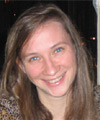 |
|||||||||||
|
|||||||||||
|
|||||||||||
|
Since spring 2002, a working group chaired by UK theorist Georg Weiglein (IPPP, Durham) has been working out how to strengthen the interplay between the LHC and the ILC and how the physics outcome of both machines can be optimized. “The combined studies carried out by the LHC/ILC Study Group open up a new kind of phenomenology”, said CERN theorist and member of the group Gudrid Moortgat-Pick. At the Large Hadron Collider, most of the collision processes will arise through the strong force and will produce strongly interacting particles which decay, for instance into electroweak particles. The latter particles will further decay, giving rise to a cascade. The masses of the involved particles can then be related to kinematical distributions of the decay cascade. The ILC, with its tuneable energy and its well-defined initial state, would give clear signatures of the electroweak events and would allow a very accurate study of the properties of the interacting particles. “If strategies for the interplay of the LHC and the ILC have been worked out, and if the physicists from both machines work on combined analyses, the physics results will be maximized”, said Moortgat-Pick. Both machines will profit from each other. The LHC is mainly a discovery machine, which will most likely observe new physics. The ILC also has a large discovery potential and the capability to precisely determine the nature of the new physics. The interplay between the two machines has been studied for a broad range of possible scenarios: the LHC could discover new physics but the interpretation of the detected signals may not be obvious. The combination of the LHC results with the precision studies at the ILC would yield a much more comprehensive picture of the underlying physics. This would enable one to predict, for instance, masses and couplings of new heavy particles. Feeding this information back to the analysis at the LHC and the ILC would reveal inconsistent model assumptions, shedding light on the underlying physics. To explore the potential of this cross-study, the theoretical ideas have to be accompanied by thorough experimental simulation studies. Detailed knowledge about the machines and detectors is needed. This is particularly valid for the complicated experimental environment at the LHC. Of course, the LHC physicists are currently focusing on the preparation of the near commissioning of the LHC. Nevertheless, there is lively activity in both communities on advancing the combined studies. At the latest LHC/ILC Study Group workshop on 13 December at CERN, news from ATLAS physics studies as well as new results on the possible interplay between the two machines were presented. These workshops take place on a regular basis. The LHC/ILC Study Group has written a 450-page report (hep-ph/0410364), presenting numerous interplay studies in the Standard Model as well as in many models for physics beyond it. The report has been accepted for publication in Physics Reports. The LHC/ILC Study Group was also asked to provide input to the questions of the EPP2010 survey of the US National Academy of Science. As the LHC will start in 2007, the focus of the LHC/ILC Study Group will soon move from studying hypothetical scenarios of new physics to the exciting task of interpreting actual data in the context of the LHC/ILC interplay.--Perrine Royole-Degieux |
|||||||||||
| © International Linear Collider |
